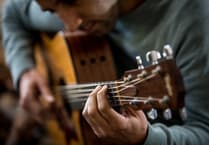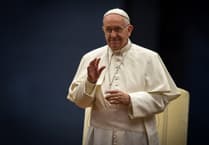ALTHOUGH a school is fundamentally a building, it’s also a state of mind, an experience, and a memory. Whether you spent your time ducking and diving through a series of detentions or were a triple-A scholar, school days have a habit of getting under your skin and staying there.
KHS in its most recent incarnation will finally fall to the wrecking ball later this year. The roofs will fall in and the bricks that built walls that housed generations will be reduced to rubble.
Yet when the dust settles and leaves an empty place where a building used to be, it’ll be the memories the school made, the experiences it engendered and the characters it helped shape that will be its enduring legacy.
The current building earmarked for demolition only opened its doors on June 10, 1963, and in terms of older and more venerable educational architectural wonders, King Henry VIII Comprehensive is more of a sapling than an oak.
Yet as an institute of learning it is one of the oldest schools in Britain.
Scratch the surface and you’ll find behind the cubist and modernist exterior that has filled the Abergavenny skyline for over half a century, there is a whole heap of history. So get your spades and let’s go digging.
The tale of a school named after a merry monarch who had a habit of killing his wives began with the Reformation of the 1530s.The monasteries were forced to shut up shop and their great wealth slowly found its way into the coffers of the Tudor King.
Henry, being a bit of a thinker as well as a glutton, thought it would be a good idea to splash a little of the cash on some good causes to ease his conscience and maybe nip any bad feeling that could lead to a French style revolution in the bud.
Using tithes previously belonging to the Benedictine priory and specifically, the tithes of Badgeworth in Gloucestershire, Abergavenny had a new school!
With St Mary’s becoming the town’s new parish church, the school also had a ready-made building to move into - the redundant church of St John’s.

Although it was called King Henry VII Free Grammar School, don’t be deceived, it was anything but. There was no groundbreaking movement to provide universal education in Abergavenny back in the day.
It just meant that there were no selection criteria and as as long as you could pay the tuition fees you could guarantee your child a place.
The school founded in 1542 initially had 26 pupils and catered only for boys aged between 7 and 14. It started at 6am and ended at 5pm, and pupils were expected to study a fine mix of logic, rhetoric, arithmetic, music, poetry, and astronomy.
Its first headmaster, appointed by King Henry VII, was Richard Oldsworthy.
Keen to keep their generous but notorious unpredictable benefactor in a good mood, the pupils were ordered to say prayers thanking him daily.
One of the catchier ones went like this, “O Lord save the King and hear us in the day when we shall call upon thee, we pray O Lord God Supreme, King of Kings preserve, we beseech thee our King Henry the Eighth, chief and only founder of this school, very long unto this society safe and flourishing, and grant that after the course of his life happily run, he may by thy mercy be advanced to the reward of Eternal Life and grant we beseech thee furthermore that Edward, the most deserving prince, may succeed his fathers in the throne, fortunate and long-lived. Amen.”
In 1664, due to financial mismanagement on behalf of the school’s trustees, the lease was taken on by Jesus College, Oxford, and marked the beginning of a close relationship between the two bastions of learning. With the one providing headmasters and the other, promising students.
However, that old bugbear, financial mismanagement continued to hinder the school, until an Act of Parliament in 1760 took the bull by the horns, restructured the school’s governance, and the new tower and Georgian master’s house, which you can still see today, was built.
Under the headmastership of the Reverend William Morgan, who was paid a vastly improved salary by Jesus College, the school went from strength to strength with between 70-80 pupils learning, living, and laughing.
Yet all good things come to an end. By the time 1818 rolled around the number of pupils had declined to 18, most of whom were on scholarships but a few paid five guineas a year for the privilege.
The once-great school was on the slide.
In 1880 a former pupil remembered just how different things once were at the school when they wrote:
“Generally speaking we were a self-willed, mischievous lot. There were some special methods of punishment, one of which was to place the offender in a large basket, and by means of a pulley in the roof, pull him up to a height of 20 to 30 feet and leave him suspended, mid heaven and earth, like Mohammed’s coffin.
I can speak with experience of the sensation attending the elevation and suspension of the culprit. The process was to me rather agreeable than otherwise, except for the loss of a meal or two, which it usually entailed.
One of the crimes for which this special punishment was reserved was that of being late for church. The scholars met in the Free School every Sunday morning to march to St Mary’s Church and woe to the luckless lad who happened to be a few minutes late. But Parson Williams, as we called him (the Reverend Thomas Williams) who was kind and benevolent to a fault, always insisted upon our immediate release when he discovered any of us sitting aloft like ‘a sweet little cherub.’
Then I remember another special mode of punishment, reserved exclusively for fighters, and it reminds me of the Turkish bastinado or the Russian Knout.
Each belligerent was deprived of his boots, placed stomach downwards across a table or desk, or on the floor, and beaten by his opponent upon the soles of his feet with a stick or cane. When a sufficient chastisement had been inflicted, places were changed and the other delinquent received his share.
When a boy had acquired sufficient knowledge he was passed on to Parson Williams, who had a school in a contiguous building, to learn Latin. I believe I was passed on because the school methods were all lost upon me, and I doubt very much whether I made any considerable progress in the study of Latin.
We paid nothing for our schooling, and I think there were 70 to 80 scholars in those days. There was no other public school in the town, and the National and British schools were not thought of. There were, however, a few small private schools, in Cow Street (Nevill Street), Monk Street, Frogmore Street, and one in Mill Street, near the Unicorn Inn.”
They say that behind every poor pupil is an even worse teacher, and when Headmaster Henry Peake, who was responsible for much of the rot, retired in the 1870s after 42 years, his replacement, James Webber breathed a new lease of life into the school.
Making it his business to revamp and sharpen up the curriculum, Weber also had two new classrooms built and by 1878 there were 73 pupils being taught by three masters at the school.
Things were back on track!
In 1887 change was in the air. Not only did the school sever its centuries-old links with Jesus College but in June of that year a foundation stone was laid at a site in Pen-y-Pound for the new King Henry VIII Grammar School.
The foundation stone was inscribed with the words, “This Grammar School was erected by the trustees of the Bedgworth Charity, assisted by inhabitants of Abergavenny and the district, to commemorate the 50th year of the reign of Her Most Gracious Majesty the Queen, and this foundation stone was laid on 21st June 1887, by Mrs Bury Capel, wife of the Chairman of Bedgworth Charity Trustees.”
Copies of the Abergavenny Chronicle, Monmouthshire Beacon, Hereford Times, South Wales Daily News, Western Mail, and The Times were placed in a bottle alongside coins of the realm and placed in a cavity beneath the stone.
Mayor Bishop expressed in a speech his hope that he “might be spared to see the school erected and thriving for years to come.”
With mallet in hand, Mrs. Capel struck the foundation stone in several places and announced to the gathered assembled, “I lay this foundation stone of the Abergavenny Grammar School to the honour and glory of God, in the name of the most blessed Trinity, the Father, Son, and Holy Ghost - Amen.”
Two years and £6,954 later the school was officially opened by the Marquees of Abergavenny on Thursday, September 29, 1898.

In the School Annual for 1899, a description reads, “It is much to be regretted that the unfavourable weather spoiled what otherwise would have been a brilliant ceremonial at the School’s doors His Lordship made his way, through drenching rain, to the Grammar School, where in spite of the wet, a large company was assembled to await his arrival. The meeting then broke up, with cheers for the Marquess, Mr. Webber, and the school.”
Out with the old and in with the new!
James Webber was thanked for his sterling service and replaced by the aptly named Mr T. Headland Sifton who was helm the school up until after the First World War.
Sadly, that bloody conflict took the lives of two King Henry VIII masters and 32 former pupils.
In 1919 Mr Newcombe picked up the reins and remained as Head for 35 years. During his tenure, Newcombe, blooded new teachers such as E.O. Jones, J.B.H. Mawer, Harold Sharpe, and Leonard Porter who made it their business to give Abergavenny a school it could be really proud of.
In 1926 the school underwent considerable refurbishment with the addition of a gymnasium, a handicrafts room, three new classrooms, and a library.
When the 1930s appeared over the horizon, the school had tripled its pre-war figure with 150 pupils and catered to the new sciences of Physics and Biology as well as a focus on Metalwork and Woodwork.
By the outbreak of the Second World War, the school had become known as "the finishing school for young gentlemen.”
Once again, another global conflict claimed the lives of 33 former pupils.
Butler’s Education Act of 1944, gave greater control to the councils to organise secondary education and after trailing a series of options, in 1963 King Henry VIII Boys’ Grammar School was amalgamated with the Girls’ Intermediate High School, and a new secondary modern was born on the old Hereford Road.
Officially opened by James Griffiths MP for Llanelly on June 10, it was the first school in Monmouthshire set up with the intention of becoming a multilateral school. It cost £181,038 to build and was situated on a 10-acre site.
In its first year, there were 216 boys and 232 girls.
In 1971 the school made the transition from a mixed grammar and merged with Grofield Secondary School to form a comprehensive, and the rest is history....

The St John’s site still stands, the old grammar school is now used by Melville Theatre, and as for the comp, well, that’s going to be smashed to smithereens relatively soon. But don’t worry there’s a bright, breezy, and modern new build waiting in the wings to take its place.
Yet the real history of any school is really the history of the thousands of pupils who have walked through the doors and learned a thing or two about a thing or two while making the sort of friends and memories that can last a lifetime.
King Henry VIII School has played a pivotal role in Abergavenny for generations and although the buildings that house it may change, the spirit that defines it lives on.
There'll be a short test on everything you've just read in 20 minutes, so we do hope you've been paying attention!




